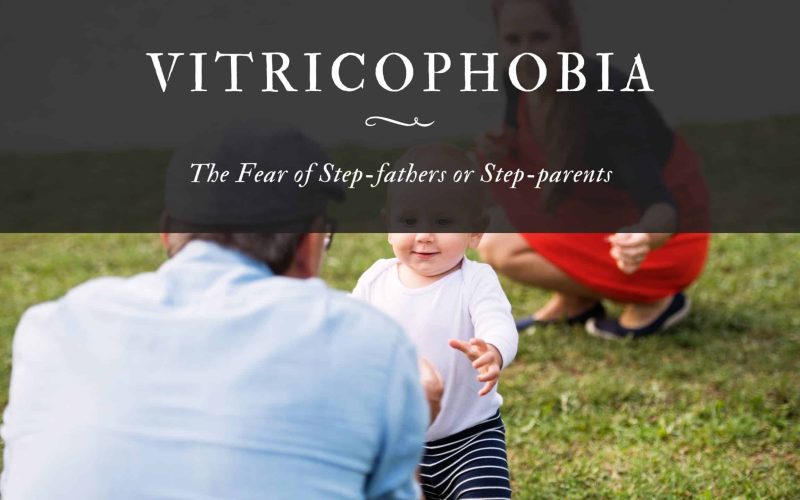One of the everyday events that occur these days is divorce. The people on the existing end are the children, and most children dread having a step-parent (especially a step-father).
For some kids, the mere mention of having a stepfather causes them to begin to have anxiety attacks. Anytime this occurs, the child can be said to be suffering from vitricophobia.
Vitricophobia can be defined as the irrational fear of one’s stepfather. The word vitricophobia is considered to be derived from a combination of two languages: Latin and Greek.
Vitricophobia is obtained from the word Vitrico(Latin), which means step-father, and phobia (Greek), which means fear. Just like any other specific phobia, vitricophobia is seen to begin in childhood.
This means that children exposed to the dangers of divorce and having to go through the emotional problems associated with having a step-father would most likely develop vitricophobia.
Causes of Vitricophobia
Just like other phobias, there are no definitive causes of vitricophobia. However, according to research, two factors play very significant roles in the development of vitricophobia.
They include;
Genetics
Genetics or heredity has been said to be one major contributing factor in the development of vitricophobia.
According to previous records of patients who have developed vitricophobia, more than 90% of these people have had a family member who has had one form of mental and anxiety disorder or another.
According to the Association of American Psychologists (APA), most people who have developed one phobia or another have had a family member who has suffered from that phobia or another anxiety disorder.
It is important to note that a person can develop a different phobia or anxiety disorder from that which the parent or family member had suffered.
For example, suppose a parent had suffered from any mental illness such as schizophrenia or any other anxiety disorder such as autophobia, politicophobia, or even vitricophobia; in that case, the child may go on to develop a different kind such as vitricophobia.
It is also vital to note that having a family member who has developed a particular phobia or mental disorder doesn’t definitely mean that you will develop it. It simply means that having a genetic predisposition will only increase your chances of having vitricophobia.
Environmental Factors
A person can have genetic predispositions but not develop any form of phobia. This is because if there are no appropriate genetic predispositions, then there will be no trigger, and as such, there will be no anxiety disorder.
However, once there are certain environmental factors in place coupled with the genetic predisposition, then the person has a higher risk of developing vitricophobia.
In most cases, certain environmental factors, such as a traumatic event that may have occurred during childhood, stories told by other children about their horrible step-father, or even watching certain movies, may trigger this phobia.
Essentially, any traumatic emotional event that revolves around the various fears that are linked with vitricophobia in any way may sometimes be enough to trigger vitricophobia as long as the person has the appropriate genes for them.
Symptoms of Vitricophobia
Those who have vitricophobia will most times avoid any form of contact with their stepfather. In some patients, this intentional avoidance of coming in contact with their fear is what triggers them to begin to experience anxiety and fear in the first place.
Most times, running away usually feels like the best thing to do; however, it is essential to know that it is only a quick fix. In the long run, what you keep running away from will eventually limit your life and emotional progress and hurt you emotionally.
Sometimes, some people who have vitricophobia don’t necessarily always have only to avoid their exact fears(step-father or their step-parents).
However, they tend to avoid situations that may trigger their fears or, in extreme cases, the thoughts of their fears.
There have been numerous cases whereby a patient who has vitricophobia starts to fear experiencing the anxiety itself because it usually makes them extremely uncomfortable immediately after they start to experience it.
Whenever patients start experiencing vitricophobia, they may likely experience panic attacks, and they can be very upsetting because they are felt on a physical level.
It is not unusual for a person who experiences panic attacks to feel palpitations, accelerated heart rates, or feelings of their heart pounding.
In extreme cases, a person doesn’t necessarily have to be exposed to the triggers to begin to experience symptoms of panic attacks that are associated with vitricophobia.
For some, the mere thought of being in contact with their step-fathers or step-parents, in General, can begin to trigger anxiety symptoms.
People are different and respond to situations regarding fear differently. As such, the symptoms a person may exhibit when experiencing vitriciophobia will differ from the next person.
Also, a person’s symptoms may vary based on how severe the levels of anxiety he or she experiences.
However, a person who experiences vitricophobia will exhibit one or more of the following symptoms:
- Excessive trembling
- An excessive outpouring of sweat
- Chills or hot flushes
- Shallow breathes or intense difficulties in breathing
- Choking sensations
- Tachycardia, which is characterized by rapid heartbeats
- Angina is characterized by severe pain and tightness in the chest.
- Nausea
- Vomiting
- Severe headaches and eventual dizziness
- Fainting or feelings of being weak and faint
- Numbness
- Pins and needle sensations in the hands and legs
- Dry mouth
- Frequently visiting the toilet
- Ringing in the ears
- Disorientation and confusion
- Hyperventilation
- Increase in body pressure
In some cases, a person may only exhibit physical symptoms. However, in other cases, a patient may exhibit physical and psychological symptoms.
Some of the psychological signs a person who has a severe case of vitricophobia will exhibit include:
- Fear of losing control
- Fear of dying
- Fear of fainting or losing consciousness
- Feelings of self-blame, guilt, and shame
- Feelings of hopelessness and sadness
- The tendency to withdraw from others
- Confusion and radical mood swings
- Anger
- Always feeling irritable
- Fear of illness and harm
- Anxiety and the inability to stay calm
Treatment of Vitricophobia
Many individuals who have vitricophobia (fear of their step-father or step-parents) often feel they don’t need treatment.
Most times, they think that once they can avoid their fear, they can reduce the anxiety that comes with it; however, they realize that their fear worsens to much more than they can handle in the long run.
Although they initially think that they have control over their problem, they soon realize that rather than having control of the problem, they are beginning to lose touch with normal.
Therefore, it is very important for anyone dealing with a phobia, including vitricophobia, to seek professional help.
By doing this, the person would come to understand the problem’s root cause and how to handle him or herself when faced with the trigger.
Although most phobias are considered curable, no specific treatment plans can solve the problem generally.
This means that there are several treatment options available, and they mostly depend on the severity of the patient’s phobia as well as the willingness of the patient to accept and do all that is required of him/her to do.
It is imperative to note that you must take treatment or start any treatment plan on your own without consulting your doctor beforehand.
Any treatment plan mentioned in this article is purely for information purposes and not specifically only for patients who have vitricophobia.
The treatment plans include:
Talking Treatments
Talking treatment, otherwise known as therapy and often includes counseling, has been seen to be great at treating specific phobias, including vitricophobia.
Talking therapies are usually laid-back treatments and are physically non-intrusive. In other words, they usually don’t require using needles or any form of objects to be carried out.
Therapies usually involve the patient having a one-on-one discussion with his or her highly trained and proficient therapist.
These discussions often include how you feel, what you think about, how you react to certain things, especially to your stepparent, and so on.
There are several different types of therapies, but their goal is often directed toward these four things;
- Help the patient recognize and see the unhelpful patterns in his/her thinking, acting, and behavior and find ways to correct and change such patterns.
- It helps you resolve certain complicated feelings that you may have, and if they can’t be fixed, it helps you find a way to live with them comfortably.
- Help provide a safe place and space to talk to someone who understands how you feel and what you feel and won’t judge you.
- It helps you make sense of the world and better understand your thoughts.
In most cases, talking therapies are the same as counseling, psychotherapy, psychological treatments, or talking treatments.
Among the numerous amounts of talking therapy that there is, there are two types of therapies that are commonly used by psychologists when it comes to dealing with specific phobias such as vitricophobia.
They include:
Cognitive Behavioral Therapy (CBT)
Cognitive Behavioral Therapy, often known as CBT, is a form of treatment based on the theory that “our behaviors are constantly influenced by what we think and perceive.”
In other words, CBT believes that what we see with our eyes, think, and perceive with our minds will constantly affect our behavior.
Every time we experience anxiety and distress, in most cases, it affects and distorts our perception of reality.
Cognitive behavioral therapy helps to identify how a person views reality and determines if their perception of reality is true and what reality is meant to be.
If their perception of reality is different, then CBT seeks to create strategies that can change their version of reality.
For example, Cognitive Behavioral Therapy aims to help a person who experiences vitricophobia identify if the anxiety and fear they experience when thinking about their stepfather or stepparent are accurate depictions of reality and, if not, find ways to help that perception.
Exposure therapy
Exposure therapy involves the patient being gradually exposed to their fears. Exposure therapy works on the notion that once a person is exposed to his or her anxiety, over time, the person builds resistance in their mind such that their fear has no hold on them anymore.
Exposure therapy is often done after Cognitive Behavioural Therapy. For this type of therapy, a person who has vitricophobia is gradually exposed to their fear in a controlled manner such that the patient comes to terms with their phobia.
In such instances, the patient would be gradually exposed to the thoughts of their step-parents.
Once the patient can handle the thoughts, the therapist can gradually show them pictures and eventually expose them to the presence of their step-parents. This way, the patient gets comfortable with one level before moving on to the next.
As such, the patient no longer feels so much anxiety and fear when the thought of having to come in contact with the stepdad or step-parent comes up.
The Use of Medications
Under some extreme circumstances, your therapist may prescribe the use of certain medications to help you cope better with your symptoms.
However, it is important to note that drugs don’t help in treating phobias, especially vitricophobia. What these medications will help out is to help you cope better with your symptoms or help reduce them.
It is also important to note that we do not advise using Medications without getting prescriptions from your doctor or therapist.
Your doctor can prescribe certain drugs as short-term solutions to the side effects of vitricophobia, which include depression and anxiety.
These drugs include:
- Beta-blockers
- Antidepressants
- Tranquilizers
Self-help
There is a saying, “Heaven help those who help themselves.” This saying can somewhat be applied here.
Your therapist can only do so much, but the best way to overcome your fear of your step-father or step-parents is to be intentional about overcoming it.
One way to do that is by taking good care of yourself. Knowing how to take care of yourself emotionally, mentally, and physically is by far a useful tool that helps you handle not only your vitricophobia but other phobias or anxieties before they become severe.








